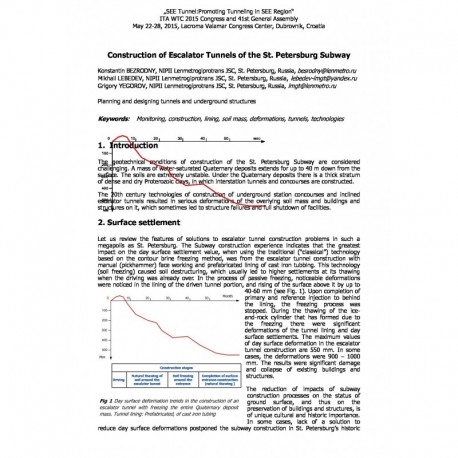Cart
0
0
No document
0,00 €
Total
Document successfully added to your shopping cart
Quantity
Total
There are 0 items in your cart.
There is 1 item in your cart.
Total documents
Total shipping
To be determined
Total
Search & filter
Search for a publication
Search & filter
Viewed documents

Construction of Escalator Tunnels of the St. Petersburg Subway
wtc2015_full_bezrodny
K. Bezrodny / M. Lebedev / G. Yegorov
The geotechnical conditions of construction of the St. Petersburg Subway are considered challenging. A mass of water-saturated Quaternary deposits extends for up to 40 m down from the surface. The soils are extremely unstable. Under the Quaternary deposits there is a thick stratum of dense and dry Proterozoic clays, in which interstation tunnels and concourses are constructed. The 20th century technologies of construction of underground station concourses and inclined escalator tunnels resulted in serious deformations of the overlying soil mass and buildings and structures on it, which sometimes led to structure failures and full shutdown of facilities. Let us review the features of solutions to escalator tunnel construction problems in such a megapolis as St. Petersburg. The Subway construction experience indicates that the greatest impact on the day surface settlement value, when using the traditional (“classical”) technology based on the contour brine freezing method, was from the escalator tunnel construction with manual (pickhammer) face working and prefabricated lining of cast iron tubbing. This technology (soil freezing) caused soil destructuring, which usually led to higher settlements at its thawing when the driving was already over. In the process of passive freezing, noticeable deformations were noticed in the lining of the driven tunnel portion, and rising of the surface above it by up to 40-60 mm (see Fig. 1). Upon completion of primary and reference injection to behind the lining, the freezing process was stopped. During the thawing of the ice-and-rock cylinder that has formed due to the freezing there were significant deformations of the tunnel lining and day surface settlements. The maximum values of day surface deformation in the escalator tunnel construction are 550 mm. In some cases, the deformations were 900 – 1000 mm. The results were significant damage and collapse of existing buildings and structures. The reduction of impacts of subway construction processes on the status of ground surface, and thus on the preservation of buildings and structures, is of unique cultural and historic importance. In some cases, lack of a solution to reduce day surface deformations postponed the subway construction in St. Petersburg’s historic


